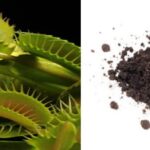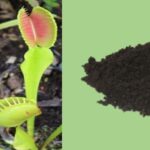As an Amazon Associate, this site earns commissions from qualifying purchases. For more details, click here.
Using the right soil is a must for any pitcher plant to survive. Because they are carnivorous, the pot soil requirement is very different from regular houseplants. In this guide you will learn the best potting media to use to get optimum results. You will also learn what mistakes to avoid when nurturing these plants.
Peat moss, perlite, long sphagnum moss and silica sand are the most ideal ingredients for pitcher plant soil. A typical pitcher plant uses a 1:1 or 2:1 mix of long sphagnum fiber and silica sand, or 1:1 peat moss and perlite.
What Potting Media Can I Use on Pitcher Plants?
There are many types of potting media you can use for pitcher plants. However there are also soil materials that you must avoid.
If you want to plant right now and not worry about any mix, we suggest Leaves and Soil Mix as it is ready to use. Follow the simple instructions and you are ready to go. If you want to do some custom mixing, read on.
The best materials for pitcher plant soil are the following. Usually the mix consists of two or more of these with a 1:1 or 2:1 ratio.
- Peat moss
- Long fiber sphagnum moss
- Perlite
- Silica or horticultural sand
- Orchid bark
Never use Miraclegro or any rich potting soil on pitcher plants, Avoid cactus and succulent soil or any rich, fertilized soil. Any soil used with regular houseplants should be avoided because they are rich in nutrients.
Nepenthes and sarracenia plants require soil but only if it is low or devoid of nutrients. The reason is carnivorous plants already get nutrients from flies, stink bugs, spiders and other prey.
Growing these plants in rich soil could be fatal. Their systems can only accept nitrogen and other nutrients from prey captured by their traps. Planting them in rich soil could overwhelm its roots and cause permanent damage.
If pitcher plants get nutrients from insects, what does it need soil for? Soil provides other benefits besides serving nutrients.
Pitcher plants use soil for anchor and balance. The material serves as support for the roots so the plant stays upright. The dirt binds itself to the roots so plants do not topple when there is wind or rain. Lastly the soil is used as repository for seeds.
While pitcher plants only grow in poor potting media, it is still essential to get the right mixture. It makes a huge difference in how well the plant grows and lives.
Pitcher Plant Soil Recipes and Mixtures
If you do not want to do any mixing, there are ready made soil for pitcher plants available. This is the best option for beginners because you can be certain the media is suitable for your plant.
If you want to prepare your own soil mix, get the right media. As long as it is nutrient free the pitcher plant should be fine. From the potting media options given earlier, there are several combinations you can use.
- 1:1 Peat moss and perlite
- 1:1 Long sphagnum moss and silica sand
- 1:1 Long sphagnum moss and perlite
- 1:1 Peat moss and silica sand
- 2:1 Peat moss and perlite
- 2:1 Long sphagnum moss and silica sand
- 2:1 Long sphagnum moss and perlite
- 2:1 Peat moss and silica sand
You can even try 3:1 mixes or combine peat moss with horticultural sand and perlite. You can do the same with long sphagnum moss.
It is also possible to grow a pitcher entirely on peat moss or long sphagnum fiber only. However it is not recommended because plants need drainage. It is best to add horticultural sand or perlite to stop soil from compressing.
So which soil mixture should you use? When you buy a pitcher plant, check what potting media is used and what ratio. Use that as a guide in case you want to propagate or repot.
Do not change the soil mix if the plant is doing well. Once you have enough experience, you can experiment with other ratios during propagation.
No matter what media combination you use, make sure to add horticultural sand or perlite. Combined with peat or long sphagnum moss, they strengthen the roots, increase aeration and solidify the soil.
Do Pitcher Plants Like Wet Soil?
All pitcher plants prefer moist soil. If the soil is too dry the plant will not survive. Similarly if it is too wet the roots could rot. If the soil feels damp when you touch it but water does not seep out, you are doing it right.
You can also use a device like the XLUX Soil Moisture Meter to check the moistness level. Press the meter into the soil at a depth of 6 inches and the readout will tell you if it is dry, wet or moist.
The key here is to water the pitcher plant properly. However the soil must be suitable for the plant. Here are some suggestions and guidelines.
The easiest approach is to follow the recommendation on the package. When you buy a pitcher plant, it will have an info sheet about soil and water requirements. Follow the instructions.
If you are growing a pitcher plant, buy ready made soil or use any of the recipes given above. Remember to add silica sand or perlite for drainage.
Once the soil is ready, water like you would any typical pitcher plant. You can place the pot on a saucer but do not sit it on water. Pitcher plants, especially nepenthes, do not thrive in the tray method. Some sarracenia variants do well here, so check what species you have first.
Keep watering until the soil is moist. Do not worry about how often you should do this. During hot days pitcher plants need more water, and in the cold season require less. Use the soil as your guide. When the soil is slowly drying up, water again until it retains moisture. This article has more information on how to water pitcher plants.
Do I Need to Repot Pitcher Plants?
You should only repot pitcher plants if the soil has compressed or the roots need more space. Some growers repot every year but most of these plants can stay in the same pot for several years. Repot immediately if you notice signs of root rot, infestation or infection.
Tip: If your sarracenia goes dormant in winter, the best time to repot is right after it comes back in spring.
- Prepare a new soil and container. Wood and plastic are the best options. You can also use ceramics (glazed) but not terracotta.
- Take the pot with the pitcher plant. Sift through the soil slowly until it loosens up.
- Hold the plant with your dominant hand, gently.
- With your other hand, hold the container and tilt it slowly. The soil will pour out.
- Gently pull the plant out of the container.
- Try to get rid of as much soil as you can. Use water if necessary.
- Look for signs of damage or rot. Prune any dead pitchers, leaves or roots.
- Prepare the new soil in the new container if you have not done so.
- Place the pitcher plant in the new soil. Water until the dirt is moist.
Your plant might get stressed out because it was suddenly moved to a new location. If it does not eat for the next few days, that is normal. You might also see a few leaves turn black or brown. Those are signs the plant is still adjusting to its new surroundings.
Give the plant a couple of weeks. Water regularly and provide 6-8 hours of sunlight. Keep the humidity at 50% or higher. The temperature should be around 65-85 degrees (18-29 C). A few degrees higher or lower is fine as long as it does not get too hot.
Once your nepenthes has grown accustomed to its new soil, it will resume feeding and growing. This applies to sarracenia and other pitcher plants.
Conclusion
Deciding what soil to use on a pitcher plant may seem daunting especially if you are a beginner. But with thorough planning you will be able to make the right decision and give your plant the proper care required for its growth.

My fascination with carnivorous plants began many, many years ago with Venus Fly Traps. Now I am more than happy to impart what I know with other enthusiasts and those who are curious about meat eating plants.



